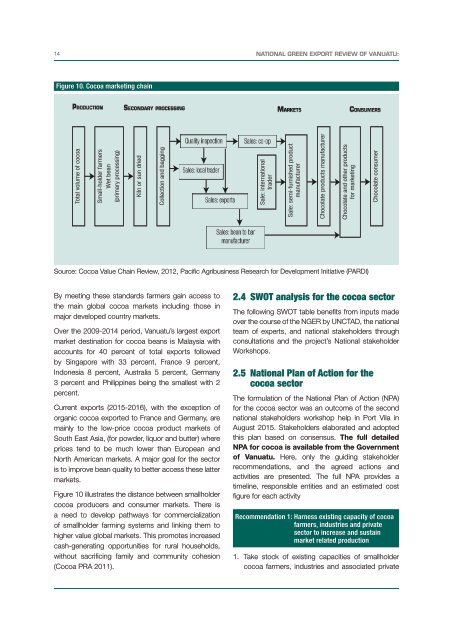VANUATU
Qffx302d60u
Qffx302d60u
Create successful ePaper yourself
Turn your PDF publications into a flip-book with our unique Google optimized e-Paper software.
14 National Green Export Review of Vanuatu:<br />
Figure 10. Cocoa marketing chain<br />
Total volume of cocoa<br />
Small-holder farmers<br />
Wet bean<br />
(primary processing)<br />
Kiln or sun dried<br />
Collection and bagging<br />
Sale: international<br />
trader<br />
Sale: semi-furnished product<br />
manufacturer<br />
Chocolate products manufacturer<br />
Chocolate and other products<br />
for marketing<br />
Chocolate consumer<br />
Source: Cocoa Value Chain Review, 2012, Pacific Agribusiness Research for Development Initiative (PARDI)<br />
By meeting these standards farmers gain access to<br />
the main global cocoa markets including those in<br />
major developed country markets.<br />
Over the 2009-2014 period, Vanuatu’s largest export<br />
market destination for cocoa beans is Malaysia with<br />
accounts for 40 percent of total exports followed<br />
by Singapore with 33 percent, France 9 percent,<br />
Indonesia 8 percent, Australia 5 percent, Germany<br />
3 percent and Philippines being the smallest with 2<br />
percent.<br />
Current exports (2015-2016), with the exception of<br />
organic cocoa exported to France and Germany, are<br />
mainly to the low-price cocoa product markets of<br />
South East Asia, (for powder, liquor and butter) where<br />
prices tend to be much lower than European and<br />
North American markets. A major goal for the sector<br />
is to improve bean quality to better access these latter<br />
markets.<br />
Figure 10 illustrates the distance between smallholder<br />
cocoa producers and consumer markets. There is<br />
a need to develop pathways for commercialization<br />
of smallholder farming systems and linking them to<br />
higher value global markets. This promotes increased<br />
cash-generating opportunities for rural households,<br />
without sacrificing family and community cohesion<br />
(Cocoa PRA 2011).<br />
2.4 SWOT analysis for the cocoa sector<br />
The following SWOT table benefits from inputs made<br />
over the course of the NGER by UNCTAD, the national<br />
team of experts, and national stakeholders through<br />
consultations and the project’s National stakeholder<br />
Workshops.<br />
2.5 National Plan of Action for the<br />
cocoa sector<br />
The formulation of the National Plan of Action (NPA)<br />
for the cocoa sector was an outcome of the second<br />
national stakeholders workshop help in Port Vila in<br />
August 2015. Stakeholders elaborated and adopted<br />
this plan based on consensus. The full detailed<br />
NPA for cocoa is available from the Government<br />
of Vanuatu. Here, only the guiding stakeholder<br />
recommendations, and the agreed actions and<br />
activities are presented. The full NPA provides a<br />
timeline, responsible entities and an estimated cost<br />
figure for each activity<br />
Recommendation 1: Harness existing capacity of cocoa<br />
farmers, industries and private<br />
sector to increase and sustain<br />
market related production<br />
1. Take stock of existing capacities of smallholder<br />
cocoa farmers, industries and associated private


